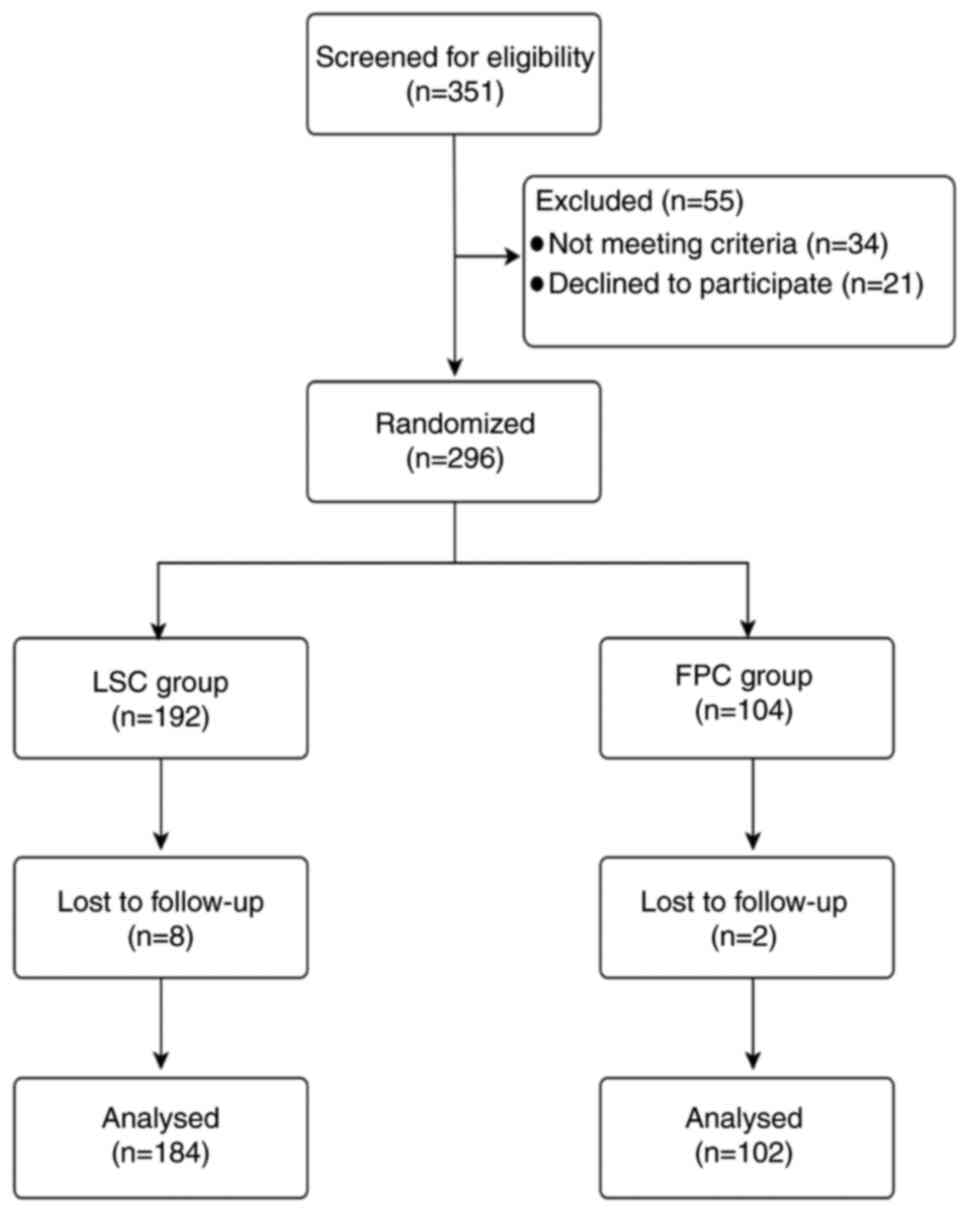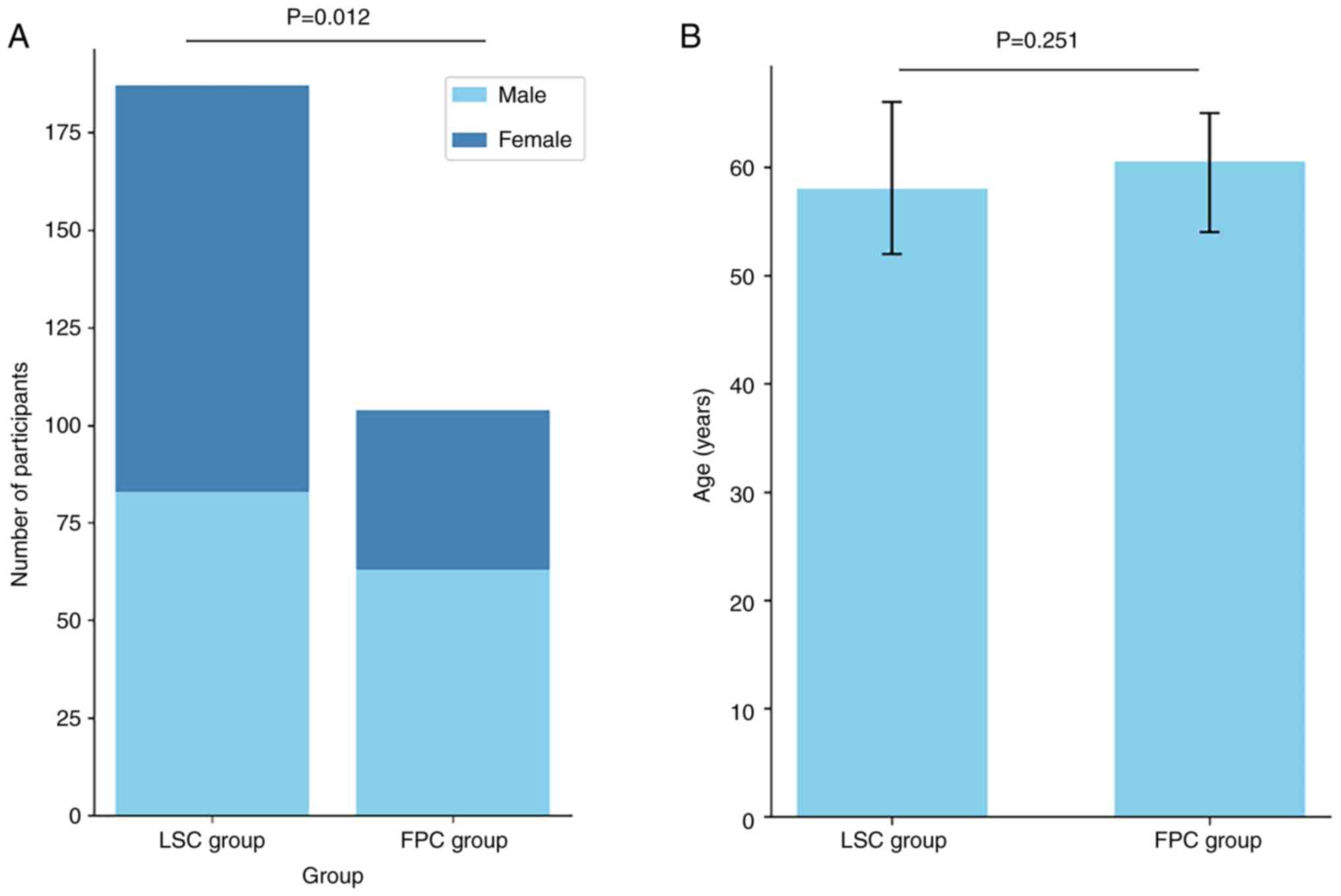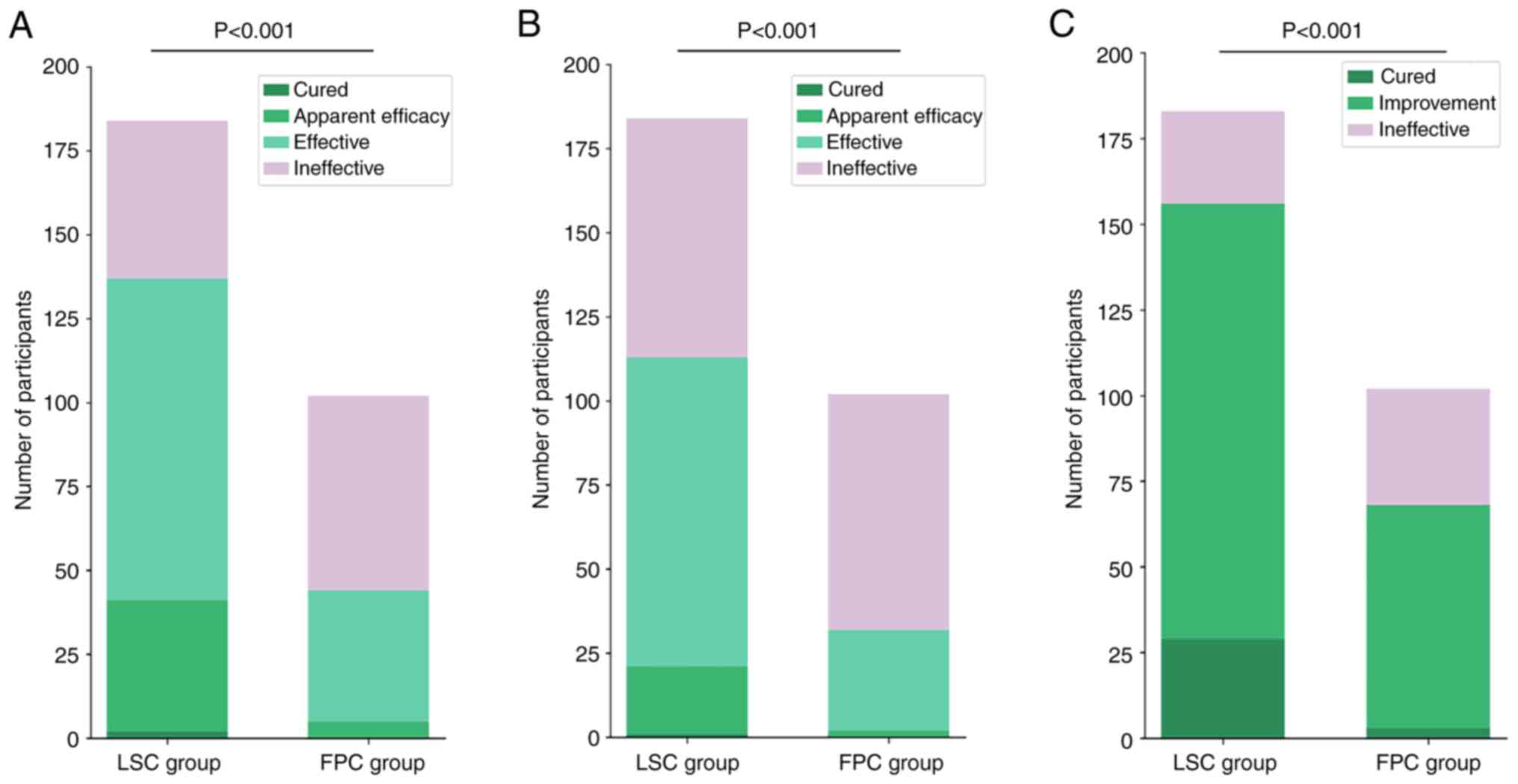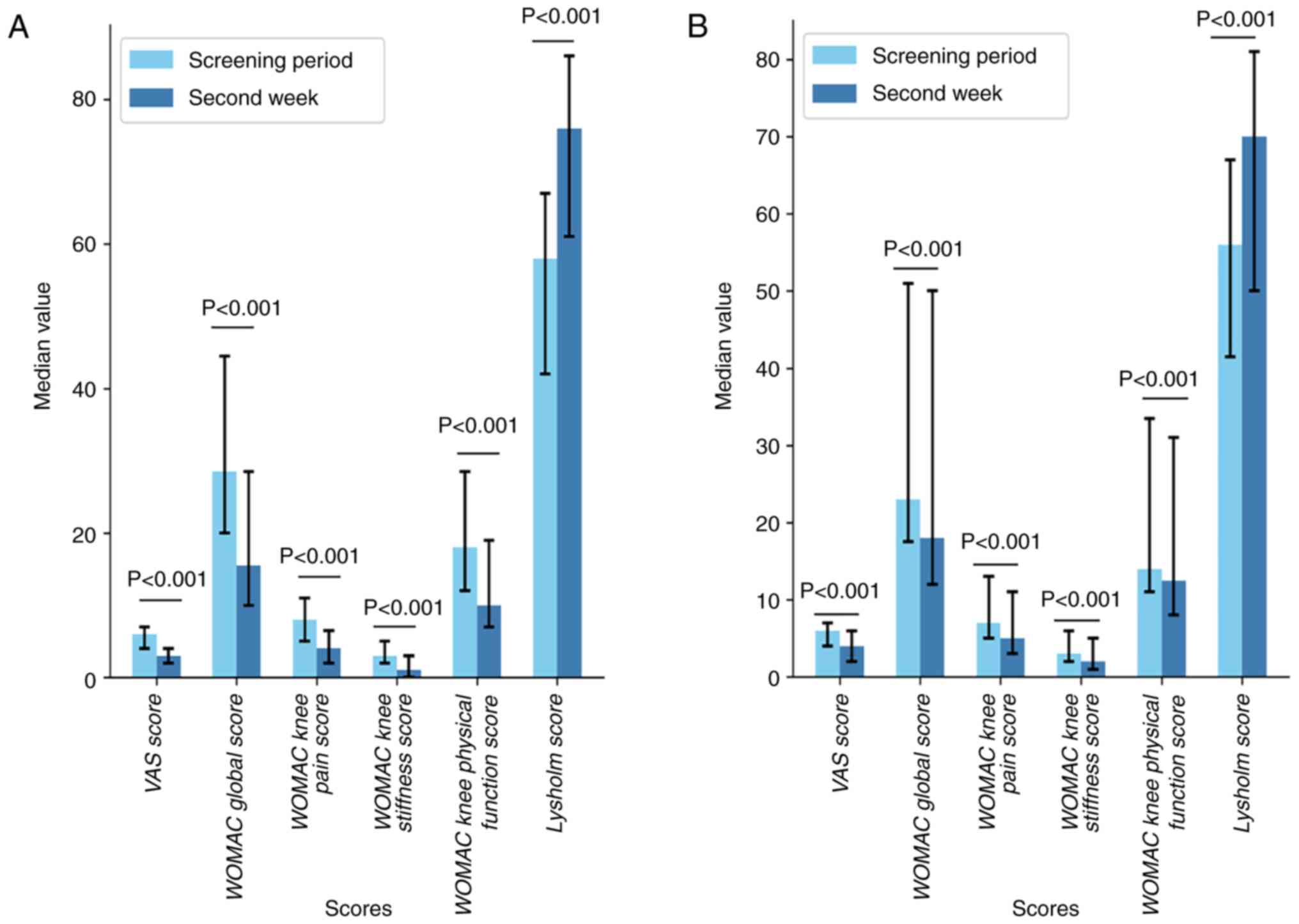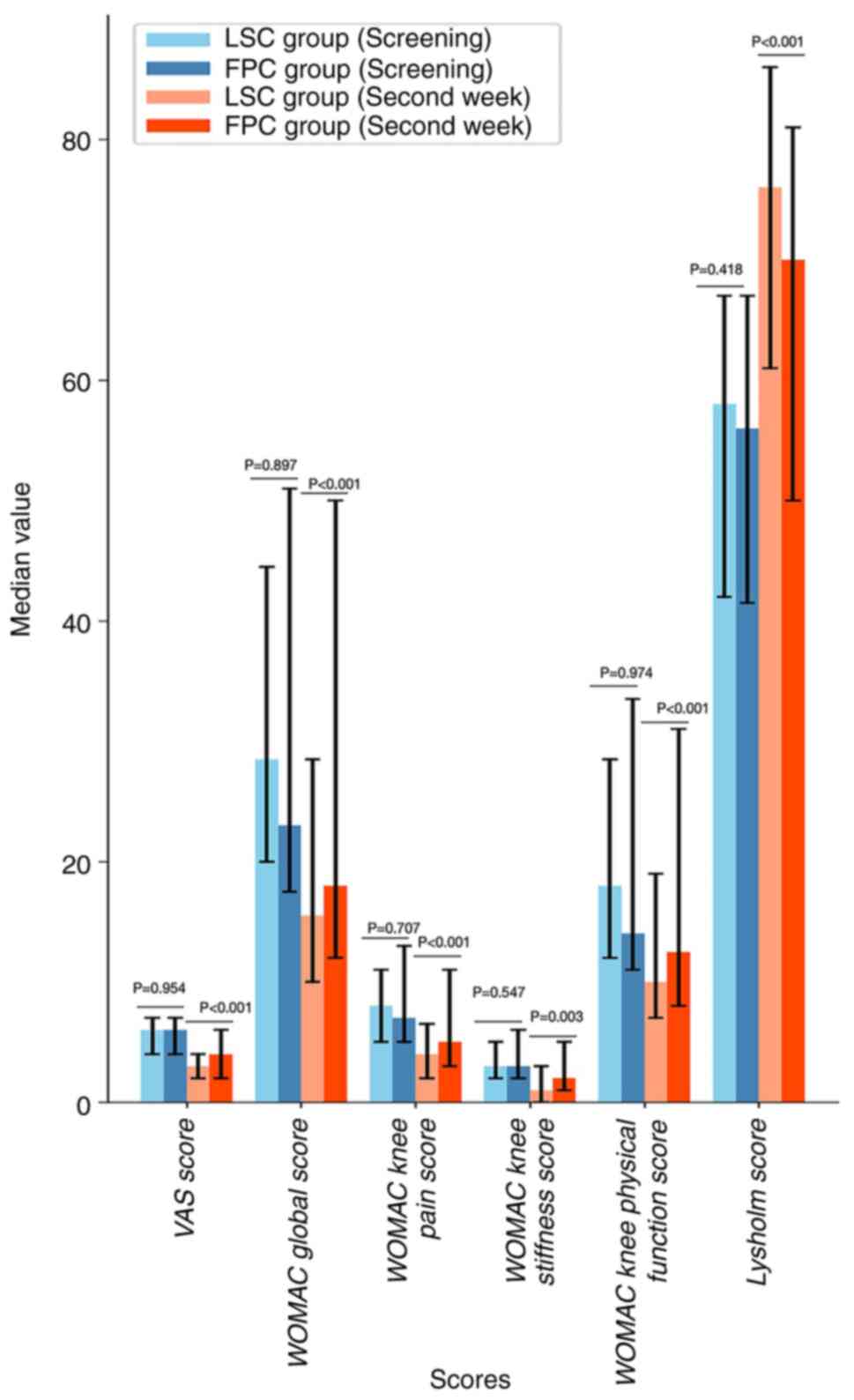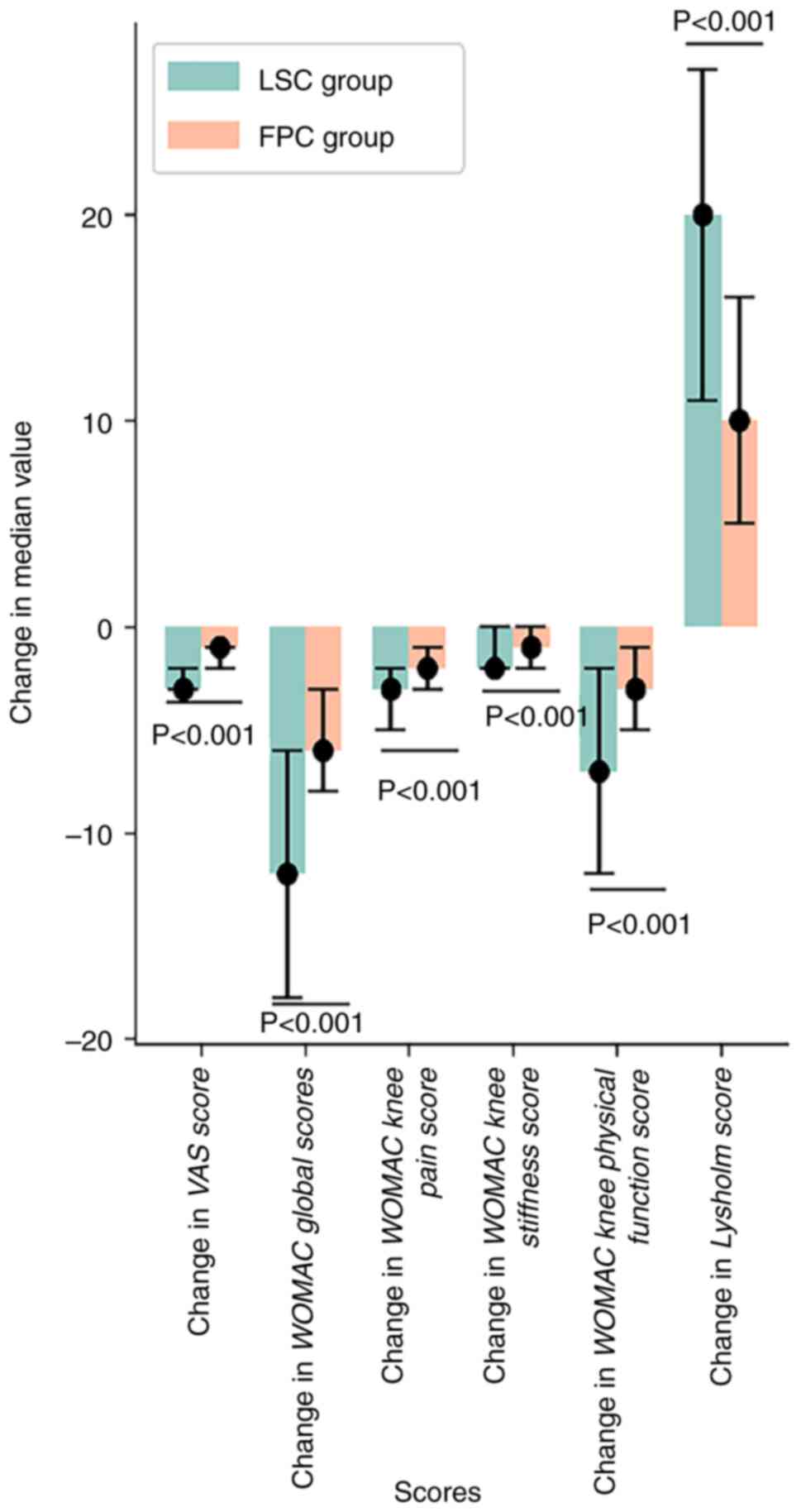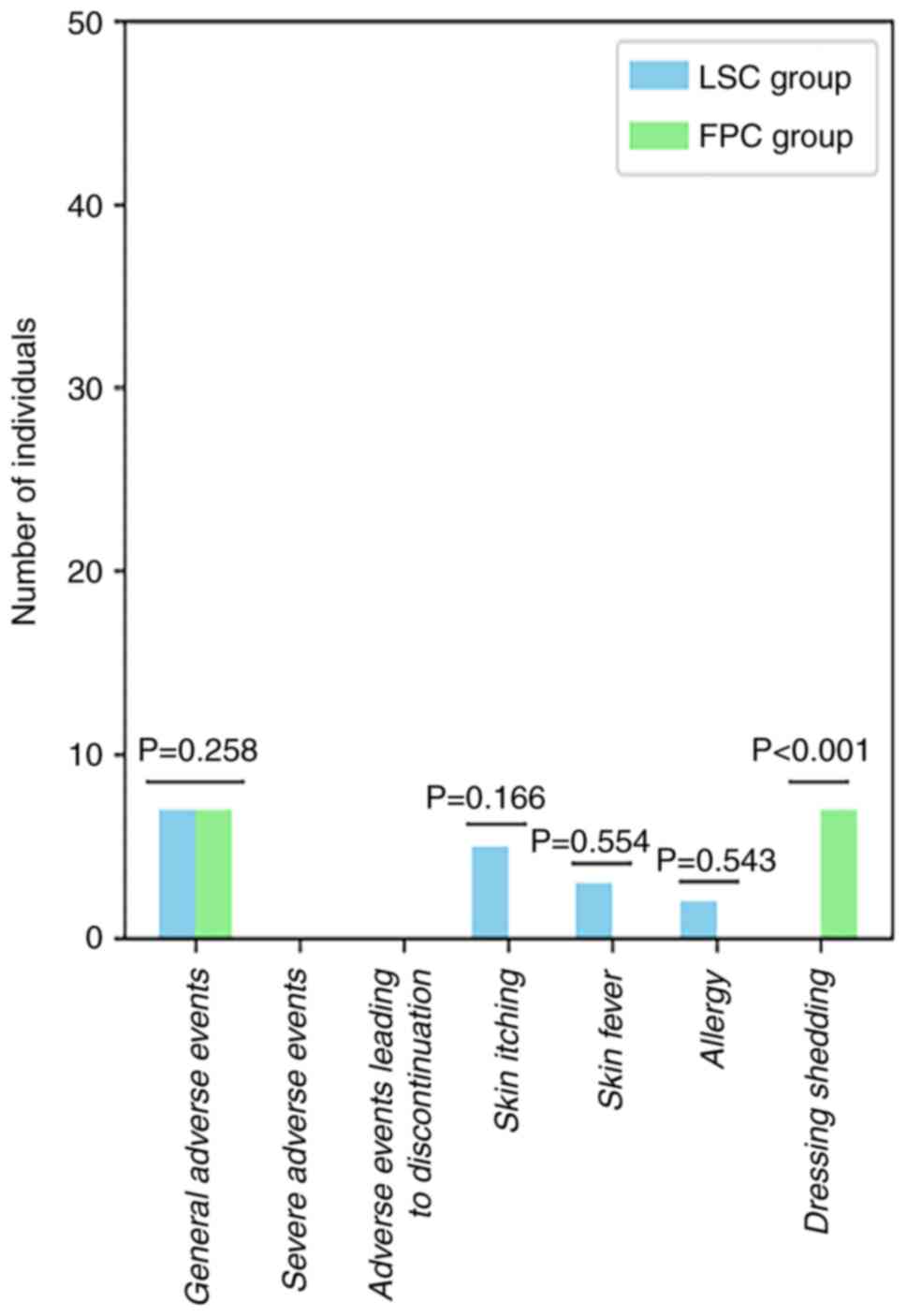Efficacy and safety of loxoprofen sodium cataplasms in the treatment of osteoarthritis: A randomized, multicenter study
- Authors:
- Published online on: February 4, 2025 https://doi.org/10.3892/br.2025.1935
- Article Number: 57
-
Copyright: © Lei et al. This is an open access article distributed under the terms of Creative Commons Attribution License.
Abstract
Introduction
Osteoarthritis (OA), among the most common joint disorders, is characterized by articular cartilage damage and involves the entirety of joint tissues, leading to the eventual degeneration, fibrosis and fracture of the articular cartilage and damage to the complete joint surface (1-3). The clinical manifestations of OA primarily include pain, stiffness, hypertrophy and restricted movement, particularly in weight-bearing joints such as knees and hips (4-6). Thus, effective pain management is important throughout OA treatment, with the selection, administration mode and dosage of medications being critical (7-10).
Topical nonsteroidal anti-inflammatory drugs (NSAIDs) can inhibit prostaglandin synthesis in the body, thereby exerting anti-inflammatory and analgesic effects and treating OA mechanistically (11). Clinical research has demonstrated that NSAIDs have a superior therapeutic efficacy in knee OA (12-14). At present, various commonly used topical formulations are available. One such formulation called cataplasms are hydrophilic polymer materials that serve as matrices for transdermal drug delivery. They possess several advantages, such as high drug-loading capacity, moisture retention capability, breathability, and non-allergenic and non-irritating properties. Common topical NSAIDs in the cataplasm form include loxoprofen sodium and flurbiprofen (15). However, head-to-head clinical studies and comparative data regarding these two drugs are lacking. Thus, the present study aimed to systematically compare the clinical effectiveness and related indicators of loxoprofen sodium cataplasm (LSC) and flurbiprofen cataplasm (FPC) in OA treatment, and to evaluate the efficacy and safety of LSC in this context.
FPC is a topical NSAIDs that is commonly used for the treatment of OA. It works by inhibiting cyclooxygenase (COX) enzymes, thereby reducing the synthesis of prostaglandins, which are mediators of inflammation and pain (16). The justification for comparing FPC and LSC in the present study was based on the need for a direct evaluation of the efficacy and safety profiles of these two commonly used topical NSAIDs in the treatment of OA. While both medications are established treatments for OA, there has been a lack of head-to-head clinical studies that provide comparative data regarding their effectiveness and safety (17,18). FPC is widely recognized and used in clinical practice for OA management (19-21); by selecting it as the control, the present study aimed to provide meaningful insights into the relative benefits of LSC. This comparison is particularly relevant given the increasing prevalence of OA and the importance of optimizing treatment options to improve patient outcomes (22,23). Osteoarthritis is a debilitating, long-lasting condition affecting the structure and function of synovial joints, affecting >200 million people globally and having doubled in incidence over the past 50 years. The present study contributed valuable evidence to inform clinical decision-making regarding the use of topical NSAIDs in OA treatment.
The 2-week follow-up was chosen to focus on the short-term efficacy and safety outcomes, which are critical for assessing the initial response to treatment in patients with OA. This duration allowed for the evaluation of immediate pain relief and functional improvement, which are often the primary concerns for patients seeking treatment. Additionally, a shorter follow-up period is common in studies evaluating topical treatments, as it enables the observation of early adverse effects and therapeutic responses without the confounding influence of long-term treatment adherence or cumulative side effects (24,25).
The scientific demand for comparing LSC and FPC arises from the increasing prevalence of OA and the need for effective management strategies that minimize systemic side effects. The two medications are widely used in clinical practice (17,18), but there is a lack of direct comparative studies that assess their efficacy and safety in a controlled environment. By addressing this gap, the present study provided essential insights that can help clinicians make informed decisions regarding the choice of topical NSAIDs for OA treatment.
Materials and methods
Ethical approval
The present study was approved by the Ethics Committees of The Second Affiliated Hospital of Xi'an Jiaotong University, Shaanxi, China [ethics approval no. Lun Shen (2023) no. 003 Xi'an, China] and The Second Affiliated Hospital of Nanchang University, Jiangxi Chian [ethics approval no Lun Shen (2022) no. 16; Nanchang, China] and Union Hospital, Tongji Medical College, Huazhong University of Science and Technology, Hubei, China [ethics approval no. Lun Shen (2021) no. (0117)-01; Wuhan, China]. The participants provided their written informed consent to participate in the present study.
Subject enrollment. Inclusion and exclusion criteria
The inclusion criteria were as follows: i) Participants voluntarily consenting to participate in the study and providing written informed consent; ii) male and female participants aged between 20 and 85 years; iii) participants clinically diagnosed with OA; iv) participants with joint pain symptoms; and v) participants taking only study-specified/control medication.
The exclusion criteria were as follows: i) Patients with bleeding disorders; ii) patients with bronchial asthma; iii) patients with severe cardiac, hepatic and renal insufficiency, with alanine aminotransferase (ALT) and aspartate aminotransferase (AST) levels exceeding twice the normal value, and serum creatinine levels exceeding the normal value. Normal values: <40 U/l for AST, <50 U/l for ALT, 35-80 µmol/l for serum creatinine; iv) pregnant and lactating women or women of childbearing age planning to conceive; v) patients with known hypersensitivity to NSAIDs; and vi) patients who participated in clinical studies of other drugs within the past month or had other concurrent diseases or complications that may affect the assessment of drug efficacy (skin breakage, infection at the site of drug application or skin rash).
Discontinuation and withdrawal criteria. The discontinuation and withdrawal criteria were as follows: i) Adverse events such as skin sensitization preventing the subject from continuing treatment; ii) unwillingness to continue treatment; iii) noncompliance with the study protocol; iv) use of prohibited drugs during the study; and v) pregnancy.
Between June 2023 and April 2024, 351 subjects from three hospitals were invited to participate. The three hospitals included The Second Affiliated Hospital of Xi'an Jiaotong University, the Second Affiliated Hospital of Nanchang University, and Union Hospital, Tongji Medical College, Huazhong University of Science and Technology. Among the subjects, 34 were excluded due to not meeting the inclusion criteria and 21 declined to participate. Additionally, two subjects in the FPC group and eight in the LSC group were lost to follow-up (Fig. 1). The LSC group included 83 male and 104 female patients, with five individuals whose sex was not recorded, totaling 192 individuals, whereas the FPC group comprised 63 male and 41 female patients. The age of the 192 participants in the LSC group ranged between 24 and 84 years, with a mean age of 58.46 years; the age of 5 individuals was not included in the analysis. In addition, the age of the 104 individuals in the FPC group ranged between 35 and 84 years, with a mean age of 59.82 years.
Research methods
The two groups received topical analgesic drugs in addition to basic treatment for 2 weeks. The basic treatment provided to all participants included non-pharmacological interventions such as physical therapy and education on joint protection techniques. LSC (Hunan Jiudian Pharmaceutical Co., Ltd.; state drug license H20173272; specifications, 100 mg/patch) was administered to the LSC group and FPC (Beijing Tide Pharmaceutical Co., Ltd.; state drug license H20103549; specifications, 40 mg/patch) was administered to the FPC group. LSC was applied topically to the affected area once daily, with one patch applied per area for 2 weeks according to the manufacturer's instruction. FPC was applied twice daily, with one patch applied per area for 2 weeks, according to the manufacturer's instructions. The treatment duration was 2 weeks and follow-up visits were scheduled at the end of the second week after the initial treatment.
Assessment. Efficacy assessment
Treatment effectiveness at week 2 was the primary indicator, and this was assessed using three types of evaluation. The first evaluation type was based on the Visual Analog Scale (VAS) score as follows (26): 0, no pain; 1-3, mild pain; 4-6, moderate pain; 7-10, severe pain; and 10, most severe pain. The efficacy index was defined as follows: Cured, efficacy index ≥95%; apparent efficacy, efficacy index between ≥70 and <95%; effective, efficacy index between ≥30 and <70%; and ineffective, efficacy index <30%. The treatment effectiveness rate was calculated as (number of cured cases + number of apparent effective cases + number of effective cases)/total number of cases x100%.
The second evaluation type was based on Western Ontario and McMaster Universities Osteoarthritis Index (WOMAC) (27-29). The criteria for cured, apparent efficacy and effective were the same as those for the first evaluation type. For patients with disease in both knees, the side of the patient with the more severe disease was evaluated and statistically analyzed. The treatment effectiveness rate was analyzed as (number of cured cases + number of apparent effective cases + number of effective cases)/total number of cases x100%.
The third evaluation type was based on the Lysholm score (30). The efficacy was defined as follows: Cured, pain and morning stiffness completely disappeared, and the Lysholm score improved by ≥30 points; improvement, improvement in pain, morning stiffness and other symptoms as well as in the Lysholm score by <30 points but ≥6 points; and ineffective, no improvement in pain, morning stiffness and other symptoms, with <6-point improvement in the Lysholm score. The treatment effectiveness rate was assessed as (number of cured cases + number of improvement cases)/total number of cases x100%.
Secondary efficacy indicators were changes in the VAS score, WOMAC global score (0-240), WOMAC knee pain score (0-50), WOMAC knee stiffness score (0-20), WOMAC knee physical function score (0-170) and Lysholm score (0-100) (28-30).
Safety assessment. The incidence of general adverse events, severe adverse events, special adverse events (including skin itching, skin fever and allergy) and dressing shedding was documented.
Statistical analysis
The study data were analyzed using SAS version 9.4 (SAS Institute). and descriptive statistics. Continuous variables are presented as the mean, standard deviation, median, 25th percentile, 75th percentile, minimum and maximum. Qualitative data are summarized as frequencies and percentages, with confidence intervals for overall percentages wherever applicable. Differences in treatment efficacy between the two groups were assessed using the χ2 test, or using Fisher's exact test where appropriate. To compare categorical variables, the χ2 test or Fisher's exact test were used as appropriate. However, for continuous variables such as data presented as the mean ± standard deviation and median, descriptive statistics were employed and appropriate parametric test including independent samples t-test and paired t-test was used. The 95% confidence interval for the difference in overall effective rates between the two groups was calculated using the Newcombe-Wilson method. P<0.05 was considered to indicate a statistically significant difference.
Results
Baseline data
Between June 2023 and April 2024, 351 subjects from three hospitals were invited to participate. Among them, 34 were excluded due to not meeting the inclusion criteria and 21 declined to participate. Additionally, 2 subjects in the FPC group and 8 in the LSC group were lost to follow-up (Fig. 1). The LSC group included 83 male and 104 female patients, with 5 individuals whose sex was not recorded, whereas the FPC group comprised 63 male and 41 female patients. A significant difference was detected between the groups in terms of sex distribution (P<0.05). The age of the 192 participants in the LSC group ranged between 24 and 84 years, with a mean age of 58.46 years; the age of 5 individuals was not included in the analysis. In addition, the age of the 104 individuals in the FPC group ranged between 35 and 84 years, with a mean age of 59.82 years. The difference in age was not significant (P>0.05; Table I; Fig. 2).
Clinical outcomes
After 2 weeks of treatment, the treatment effectiveness rate in the LSC group was 74.46% according to the VAS score, 61.41% according to the WOMAC global score and 85.25% according to the Lysholm score. By comparison, in the FPC group, the rates were 43.14, 31.37 and 66.67%, respectively (Table II, Table III and Table IV). Across the primary indicators, the LSC group achieved significantly higher effectiveness rates compared with the FPC group (P<0.05; Fig. 3). Newcombe-Wilson analysis confirmed this advantage, indicating that the lower limit of the 95% confidence interval exceeded zero for differences in treatment effectiveness between the LSC and FPC groups, indicating the superiority of LSC treatment (Table II, Table III and Table IV).
Table IITreatment effectiveness rate (based on the Visual Analog Scale score) after 2 weeks of treatment. |
Table IIITreatment effectiveness rate (based on Western Ontario and McMaster Universities Osteoarthritis Index global score) after 2 weeks of treatment. |
During the screening period, no significant differences were observed between the two groups in terms of the VAS score, WOMAC global score (encompassing pain, stiffness and physical function scores) and Lysholm score (P>0.05; Table VII). After 2 weeks of treatment, both the LSC and FPC groups showed reductions in the WOMAC global score (including scores for knee pain, stiffness and physical function) and VAS score compared with scores at the screening period, with their Lysholm score increasing (P<0.05; Tables V and VI; Fig. 4). Furthermore, after 2 weeks of treatment, the LSC group exhibited a lower WOMAC global score and VAS score and higher Lysholm score compared with the FPC group (P<0.05), indicating that the therapeutic effect of LSC was superior to that of FPC (Tables VII and VIII; Figs. 5 and 6).
Safety
The FPC group experienced a higher rate of adverse events (P>0.05) and dressing shedding (P<0.05) compared with the LSC group, while the LSC group had more specific adverse events than the FPC group, including skin itching, skin fever and allergy (P>0.05; Table IX; Fig. 7).
Discussion
OA is a degenerative joint disease that markedly impairs the quality of life of patients, and is primarily characterized by joint pain, pressure sensitivity, restricted movement and joint deformity, which together contribute to decreased bodily function and diminished quality of life (31,32). The prevalence of OA has been increasing with aging and obesity trends; from 1990-2019 >50% of individuals aged >65 years in China suffer from OA, a leading cause of pain and disability among the elderly (33-35). The American College of Rheumatology, Arthritis Foundation, Osteoarthritis Research Society International and European Society for Clinical Economics of Osteoporosis all recommend NSAIDs as a cornerstone of pharmacological treatment and pain management for OA (12,36-38). However, prolonged or frequent oral NSAIDs use can lead to tolerance and safety concerns, particularly in the elderly and those with comorbidities (39,40). Furthermore, NSAIDs overuse is associated with adverse gastrointestinal, cardiovascular, renal and hepatic events (41,42). Topical NSAIDs formulations, which minimize systemic exposure, are thus recommended for managing OA symptoms in middle-aged and elderly patients (40).
Loxoprofen sodium, a novel NSAIDs and propionic acid derivative, exerts its pharmacological effects by inhibiting COX enzymes, thereby blocking the conversion of arachidonic acid to prostaglandins. This inhibition leads to anti-inflammatory, analgesic and antipyretic effects (43). The control group in the present study was selected based on the common clinical practice of using FPC as a standard treatment for OA. Flurbiprofen is a well-established topical NSAID with documented efficacy and safety in managing OA symptoms (44). By comparing LSC against the established FPC treatment, the present study aimed to provide a meaningful evaluation of the efficacy and safety profile of LSC. The selection of FPC as a control enabled a direct comparison of treatment outcomes, thereby enhancing the clinical relevance of the findings.
After 2 weeks of treatment, the LSC group had treatment effectiveness rates of 74.46 (VAS score), 61.41 (WOMAC global score) and 85.25% (Lysholm score). In comparison, the FPC group achieved rates of 43.14, 31.37 and 66.67%, respectively. Across the primary indicators, the LSC group exhibited significantly higher effectiveness (P<0.05). Additionally, after two weeks of treatment, the LSC group had a lower WOMAC knee pain score and VAS score than the FPC group (P<0.05), indicating more effective pain management. The LSC group exhibited a lower WOMAC knee stiffness score and improved physiological function score in addition to a higher Lysholm score compared with the FPC group (P<0.05), suggesting superior knee function recovery. This enhanced performance may be attributed to the rapid absorption and distribution of loxoprofen sodium and its active metabolites, making it one of the fastest-acting NSAIDs available (45). Of note, the LSC group was administered a higher daily dose of loxoprofen sodium (100 mg) compared with that administered to the FPC group (flurbiprofen; 80 mg), LSC can more effectively alleviate knee joint pain in patients, which contributes to significant early symptomatic improvement in patients.
After 2 weeks of treatment, the FPC group exhibited a higher rate of dressing shedding compared with the LSC group (P<0.05), which may be attributed to FPC being applied twice as often as LSC. However, there was no significant difference between the LSC and FPC groups with respect to general adverse events, skin itching, skin fever or allergies (P>0.05). Despite the LSC group receiving a daily dose of 100 mg of loxoprofen sodium compared with the FPC group receiving 80 mg daily dose of flurbiprofen, the incidence of adverse events did not differ markedly, indicating comparable safety profiles for the two treatment options.
The baseline data indicated a disparity in terms of sex between the LSC and FPC groups, probably attributable to the small sample size. In a randomized controlled trial, comparability between the two groups is essential and inherent to the study design. The LSC group contained a higher proportion of women, who, according to a previous study, may experience heightened pain sensitivity in arthritic conditions (46). Nevertheless, the LSC group exhibited superior outcomes after 2 weeks of treatment, suggesting that LSC exhibited more effective short-term results than FPC. LSC and FPC both belong to the class of NSAIDs and exert their analgesic and anti-inflammatory effects primarily through the inhibition of COX enzymes (40,44). LSC selectively inhibits COX-1 and COX-2, leading to a reduction in the synthesis of prostaglandins, which are mediators of pain and inflammation (43). By contrast, FPC also inhibits both COX-1 and COX-2 but may have a slightly different affinity for these enzymes, which can influence its overall efficacy and side effect profile (44). The differences in the mechanism of action may contribute to variations in the onset and duration of analgesic effects between the two drugs (47). The pharmacokinetic profiles of LSC and FPC differ in several aspects. LSC is known for its rapid absorption and distribution, which allows for a quicker onset of analgesic effects. It is primarily metabolized in the liver and its metabolites have a longer half-life, providing sustained therapeutic action. By contrast, FPC has a slower absorption rate and may take a longer time to reach the peak plasma concentration. Additionally, the pharmacokinetics of FPC can be influenced by factors such as formulation and skin permeability, which may affect its overall efficacy in topical applications (45). These pharmacokinetic differences may serve a role in the observed variations in treatment effectiveness and safety profiles between LSC and FPC in the management of OA.
A previous study obtained results that the analgesic effect of FPC in the treatment of OA is superior to that of LSC, which contradicts the findings of the present study (47), which may be attributed to the current study assessing short-term efficacy (2 weeks), while the aforementioned study evaluated long-term efficacy (4 weeks). Thus, although LSC was associated with improved initial results, FPC showed greater effectiveness with longer use. The current study emphasized early pain relief and functional recovery, whereas the other study focused on sustained pain relief and long-term safety. Therefore, the opposing conclusions may have resulted from the different time points of efficacy evaluation.
The present study has several limitations. First, the sample size was small, limiting the ability to draw more broadly applicable conclusions from the results. Second, the brief observation period was insufficient to evaluate long-term efficacy and potential gastrointestinal and cardiovascular adverse events. Third, other biomarkers that could also be relevant for assessing safety in both animal and human use were not analyzed. These include liver function tests (such as ALT and AST levels), renal function tests (such as serum creatinine level) and gastrointestinal biomarkers (such as fecal occult blood). Additionally, inflammatory markers (such as C-reactive protein) and pain biomarkers (such as substance P level) may provide additional insights into the safety profile of the treatments. Future studies should consider incorporating these additional biomarkers to enhance the comprehensiveness of safety assessments. Finally, the absence of blinding may have introduced bias. In the future, a larger sample size will be employed to ensure the accuracy of the study, the follow-up period will be extended to clarify the long-term efficacy and side effects of the drug, and blinding shall be performed to reduce bias.
In conclusion, OA could be effectively treated with both LSC and FPC. However, LSC had a higher short-term efficacy, lower dressing removal rate and improved effect on the knee joints of patients with OA compared with FPC. Thus, LSC is a safe and effective treatment for OA.
Acknowledgements
Not applicable.
Funding
Funding: The present study was supported by the Key Program of Shaanxi Province (grant no. 2023-YBSF-102).
Availability of data and materials
The data generated in the present study may be requested from the corresponding author.
Authors' contributions
All the authors contributed substantially to the conception and design of the study. YL and ZL conceived and designed the work, collected original data, wrote and edited the manuscript and confirmed the authenticity of the raw data. GG, SL, XG and QL collected original data. XJ, PY and RT directed the conception and design of the work. All authors have read and approved the final manuscript.
Ethics approval and consent to participate
The present study was approved by the Ethics Committees of The Second Affiliated Hospital of Xi'an Jiaotong University, Shaanxi, China [ethics approval nos. Lun Shen (2023) no. 003 and Lun Shen (2022) no. 16; Xi'an, China] and Union Hospital, Tongji Medical College, Huazhong University of Science and Technology, Hubei, China [ethics approval no. Lun Shen (2021) no. (0117)-01; Wuhan, China]. The patients/participants provided their written informed consent to participate in the present study. The present study was registered at Chinese Clinical Trial Register (chictr.org.cn; ChiCTR2300072504). Date of registration: June 15, 2023.
Patient consent for publication
Not applicable.
Competing interests
The authors declare that they have no competing interests.
References
|
Bennell KL, Paterson KL, Metcalf BR, Duong V, Eyles J, Kasza J, Wang Y, Cicuttini F, Buchbinder R, Forbes A, et al: Effect of intra-articular platelet-rich plasma vs placebo injection on pain and medial tibial cartilage volume in patients with knee osteoarthritis: The RESTORE Randomized Clinical Trial. JAMA. 326:2021–2030. 2021.PubMed/NCBI View Article : Google Scholar | |
|
Katz JN, Arant KR and Loeser RF: Diagnosis and treatment of hip and knee osteoarthritis. A review. JAMA. 325:568–578. 2021.PubMed/NCBI View Article : Google Scholar | |
|
Duong V, Oo WM, Ding C, Culvenor AG and Hunter DJ: Evaluation and treatment of knee pain: A review. JAMA. 330(1568)2023.PubMed/NCBI View Article : Google Scholar | |
|
Neogi T and Colloca L: Placebo effects in osteoarthritis: Implications for treatment and drug development. Nat Rev Rheumatol. 19:613–626. 2023.PubMed/NCBI View Article : Google Scholar | |
|
Duan X, Zhao Y, Zhang J, Kong N, Cao R, Guan H, Li Y, Wang K, Yang P and Tian R: Prediction of early functional outcomes in patients after robotic-assisted total knee arthroplasty: A nomogram prediction model. Int J Surg. 109:3107–3116. 2023.PubMed/NCBI View Article : Google Scholar | |
|
Tian R, Duan X, Kong N, Li X, Wang J, Tian H, Shi Z, Yan S, Lyu J, Wang K and Yang P: Robotic-assisted total knee arthroplasty is more advantageous for knees with severe deformity: A randomized controlled trial study design. Int J Surg. 109:287–296. 2023.PubMed/NCBI View Article : Google Scholar | |
|
Geenen R, Overman CL, Christensen R, åsenlöf P, Capela S, Huisinga KL, Husebø MEP, Köke AJA, Paskins Z, Pitsillidou IA, et al: Eular recommendations for the health professional's approach to pain management in inflammatory arthritis and osteoarthritis. Ann Rheum Dis. 77:797–807. 2018.PubMed/NCBI View Article : Google Scholar | |
|
Bichsel D, Liechti FD, Schlapbach JM and Wertli MM: Cross-sectional analysis of recommendations for the treatment of hip and knee osteoarthritis in clinical guidelines. Arch Phys Med Rehabil. 103:559–569.e5. 2022.PubMed/NCBI View Article : Google Scholar | |
|
Geraghty T, Obeidat AM, Ishihara S, Wood MJ, Li J, Lopes EBP, Scanzello CR, Griffin TM, Malfait AM and Miller RE: Age-associated changes in knee osteoarthritis,pain-related behaviors, and dorsal root ganglia immunophenotyping of male and female mice. Arthritis Rheumatol. 75:1770–1780. 2023.PubMed/NCBI View Article : Google Scholar | |
|
Hunter DJ, Mclachlan AJ, Carroll PR, Wakefield TAN and Stosic R: Health literacy and appropriateness of self-care and pain management in osteoarthritis: An understanding of the patient's perspective. Arthritis Care Res (Hoboken). 75:848–859. 2023.PubMed/NCBI View Article : Google Scholar | |
|
Greig SL and Garnock-Jones KP: Loxoprofen: A review in pain and inflammation. Clin Drug Investig. 36:771–781. 2016.PubMed/NCBI View Article : Google Scholar | |
|
Bannuru RR, Osani MC, Vaysbrot EE, Arden NK, Bennell K, Bierma-Zeinstra SMA, Kraus VB, Lohmander LS, Abbott JH, Bhandari M, et al: OARSI guidelines for the non-surgical management of knee, hip, and polyarticular osteoarthritis. Osteoarthritis Cartilage. 27:1578–1589. 2019.PubMed/NCBI View Article : Google Scholar | |
|
Arden NK, Perry TA, Bannuru RR, Bruyère O, Cooper C, Haugen IK, Hochberg MC, McAlindon TE, Mobasheri A and Reginster JY: Non-surgical management of knee osteoarthritis: Comparison of ESCEO and OARSI 2019 guidelines. Nat Rev Rheumatol. 17:59–66. 2019. | |
|
Weng Q, Goh S, Wu J, Persson MSM, Wei J, Sarmanova A, Li X, Hall M, Doherty M, Jiang T, et al: Comparative efficacy of exercise therapy and oral non-steroidal anti-inflammatory drugs and paracetamol for knee or hip osteoarthritis: A network meta-analysis of randomised controlled trials. Br J Sports Med. 57:990–996. 2023. | |
|
Chen GY, Zhou CQ, Li H and Mao XZ: Efficacy and safety of topical nsaids combined with physiotherapy for frozen shoulder: A randomized controlled trial. Eur Rev Med Pharmacol Sci. 28:3761–3770. 2024.PubMed/NCBI View Article : Google Scholar | |
|
Voilley N: Acid-sensing ion channels (ASICs): New targets for the analgesic effects of non-steroid anti-inflammatory drugs (NSAIDs). Curr Drug Targets Inflamm Allergy. 3:71–79. 2004.PubMed/NCBI View Article : Google Scholar | |
|
Li P, Li H, Shu X, Wu M, Liu J, Hao T, Cui H and Zheng L: Intra-articular delivery of flurbiprofen sustained release thermogel: Improved therapeutic outcome of collagenase II-induced rat knee osteoarthritis. Drug Deliv. 27:1034–1043. 2020.PubMed/NCBI View Article : Google Scholar | |
|
Mu R, Bao CD, Chen ZW, Zheng Y, Wang GC, Zhao DB, Hu SX, Li YJ, Shao ZW, Zhang ZY, et al: Efficacy and safety of loxoprofen hydrogel patch versus loxoprofen tablet in patients with knee osteoarthritis: A randomized controlled non-inferiority trial. Clin Rheumatol. 35:165–173. 2016.PubMed/NCBI View Article : Google Scholar | |
|
Iguchi M, Takahashi T and Takeshita K: Effectiveness and adherence rate of s-flurbiprofen plaster for the pain management of patients with moderate and end-stage knee osteoarthritis. Cureus. 15(e44556)2023.PubMed/NCBI View Article : Google Scholar | |
|
Lin T, Liu Z, Ji W and Zhang P: Effects of knee debridement with flurbiprofen on knee function, inflammatory levels, and bone metabolism activity in patients with knee osteoarthritis. Comput Math Methods Med. 2022(8031360)2022.PubMed/NCBI View Article : Google Scholar | |
|
Tomatsu K, Yasuda S, Fuady A, Matsumoto H and Sumariyono : Efficacy and safety of s-flurbiprofen plaster in knee osteoarthritis patients: A 2-week randomized controlled phase III clinical trial compared to diclofenac gel. Int J Rheum Dis. 25:563–570. 2022.PubMed/NCBI View Article : Google Scholar | |
|
Pereira D, Ramos E and Branco J: Osteoarthritis. Acta Med Port. 28:99–106. 2015.PubMed/NCBI View Article : Google Scholar | |
|
Wathier M, Lakin BA, Cooper BG, Bansal PN, Bendele AM, Entezari V, Suzuki H, Snyder BD and Grinstaff MW: A synthetic polymeric biolubricant imparts chondroprotection in a rat meniscal tear model. Biomaterials. 182:13–20. 2018.PubMed/NCBI View Article : Google Scholar | |
|
Lin JB, Poh S and Panitch A: Controlled release of anti-inflammatory peptides from reducible thermosensitive nanoparticles suppresses cartilage inflammation. Nanomedicine. 12:2095–2100. 2016.PubMed/NCBI View Article : Google Scholar | |
|
Garriga C, Sánchez-Santos MT, Judge A, Hart D, Spector T, Cooper C and Arden NK: Predicting incident radiographic knee osteoarthritis in middle-aged women within four years: The importance of knee-level prognostic factors. Arthritis Care Res (Hoboken). 72:88–97. 2020.PubMed/NCBI View Article : Google Scholar | |
|
Jones IA, Togashi R, Wilson ML, Heckmann N and Vangsness CT Jr: Intra-articular treatment options for knee osteoarthritis. Nat Rev Rheumatol. 15:77–90. 2019.PubMed/NCBI View Article : Google Scholar | |
|
Boer CG, Radjabzadeh D, Medina-Gomez C, Garmaeva S, Schiphof D, Arp P, Koet T, Kurilshikov A, Fu J, Ikram MA, et al: Intestinal microbiome composition and its relation to joint pain and inflammation. Nat Commun. 10(4881)2019.PubMed/NCBI View Article : Google Scholar | |
|
Belk JW, Lim JJ, Keeter C, Mcculloch PC, Houck DA, Mccarty EC, Frank RM and Kraeutler MJ: Patients with knee osteoarthritis who receive platelet-rich plasma or bone marrow aspirate concentrate injections have better outcomes than patients who receive hyaluronic acid: Systematic review and meta-analysis. Arthroscopy. 39:1714–1734. 2023.PubMed/NCBI View Article : Google Scholar | |
|
Stonehouse W, Benassi-Evans B, Bednarz J, Vincent AD, Hall S and Hill C: Krill oil improved osteoarthritic knee pain in adults with mild to moderate knee osteoarthritis: A 6-month multicenter, randomized, double-blind, placebo-controlled trial. Am J Clin Nutr. 116:672–685. 2022.PubMed/NCBI View Article : Google Scholar | |
|
Migliorini F, Schäfer L, Bell A, Weber CD, Vecchio G and Maffulli N: Meniscectomy is associated with a higher rate of osteoarthritis compared to meniscal repair following acute tears: A meta-analysis. Knee Surg Sports Traumatol Arthrosc. 31:5485–5495. 2023.PubMed/NCBI View Article : Google Scholar | |
|
O'Neill TW and Felson DT: Mechanisms of osteoarthritis (OA) pain. Curr Osteoporos Rep. 16:611–616. 2018.PubMed/NCBI View Article : Google Scholar | |
|
Perrot S, Trouvin AP and Bouhassira D: Three dimensions of pain in osteoarthritis: Development and validation of the osteoarthritis symptom inventory scale. Pain. 164:1566–1577. 2023.PubMed/NCBI View Article : Google Scholar | |
|
Allen KD, Thoma LM and Golightly YM: Epidemiology of osteoarthritis. Osteoarthritis Cartilage. 30:184–195. 2022.PubMed/NCBI View Article : Google Scholar | |
|
Cui A, Li H, Wang D, Zhong J, Chen Y and Lu H: Global, regional prevalence, incidence and risk factors of knee osteoarthritis in population-based studies. EClinicalMedicine. 29-30(100587)2020.PubMed/NCBI View Article : Google Scholar | |
|
Long H, Liu Q, Yin H, Wang K, Diao N, Zhang Y, Lin J and Guo A: Prevalence trends of site-specific osteoarthritis from 1990 to 2019: Findings from the global burden of disease study 2019. Arthritis Rheumatol. 74:1172–1183. 2022.PubMed/NCBI View Article : Google Scholar | |
|
Kolasinski SL, Neogi T, Hochberg MC, Oatis C, Guyatt G, Block J, Callahan L, Copenhaver C, Dodge C, Felson D, et al: 2019 American college of rheumatology/arthritis foundation guideline for the management of osteoarthritis of the hand, hip, and knee. Arthritis Care Res (Hoboken). 72:149–162. 2020.PubMed/NCBI View Article : Google Scholar | |
|
Bruyère O, Honvo G, Veronese N, Arden NK, Branco J, Curtis EM, Al-Daghri NM, Herrero-Beaumont G, Martel-Pelletier J, Pelletier JP, et al: An updated algorithm recommendation for the management of knee osteoarthritis from the european society for clinical and economic aspects of osteoporosis, osteoarthritis and musculoskeletal diseases (ESCEO). Semin Arthritis Rheum. 49:337–350. 2019.PubMed/NCBI View Article : Google Scholar | |
|
Mezey GA, Máté Z and Paulik E: Factors influencing pain management of patients with osteoarthritis: A cross-sectional study. J Clin Med. 11(1352)2022.PubMed/NCBI View Article : Google Scholar | |
|
Schjerning A, Mcgettigan P and Gislason G: Cardiovascular effects and safety of (non-aspirin) NSAIDs. Nat Rev Cardiol. 17:574–584. 2020.PubMed/NCBI View Article : Google Scholar | |
|
Zeng C, Wei J, Persson MSM, Sarmanova A, Doherty M, Xie D, Wang Y, Li X, Li J, Long H, et al: Relative efficacy and safety of topical non-steroidal anti-inflammatory drugs for osteoarthritis: A systematic review and network meta-analysis of randomised controlled trials and observational studies. Br J Sports Med. 52:642–650. 2018.PubMed/NCBI View Article : Google Scholar | |
|
Da Costa BR, Pereira TV, Saadat P, Rudnicki M, Iskander SM, Bodmer NS, Bobos P, Gao L, Kiyomoto HD, Montezuma T, et al: Effectiveness and safety of non-steroidal anti-inflammatory drugs and opioid treatment for knee and hip osteoarthritis: Network meta-analysis. BMJ. 375(n2321)2021.PubMed/NCBI View Article : Google Scholar | |
|
Ozen G, Pedro S and Michaud K: Major adverse cardiovascular events and mortality with opioids versus NSAIDs initiation in patients with rheumatoid arthritis. Ann Rheum Dis. 82:1487–1494. 2023.PubMed/NCBI View Article : Google Scholar | |
|
Ji C, Yu Y, Zhang M, Yu W and Dong S: Loxoprofen sodium alleviates oxidative stress and apoptosis induced by angiotensin II in human umbilical vein endothelial cells (HUVECs). Drug Des Devel Ther. 14:5087–5096. 2020.PubMed/NCBI View Article : Google Scholar | |
|
Nelson AE: Osteoarthritis year in review 2017: Clinical. Osteoarthritis Cartilage. 26:319–325. 2018.PubMed/NCBI View Article : Google Scholar | |
|
Kien NT, Geiger P, Van Chuong H, Cuong NM, Van Dinh N, Pho DC, Anh VT and Giang NT: Preemptive analgesia after lumbar spine surgery by pregabalin and celecoxib: A prospective study. Drug Des Devel Ther. 13:2145–2152. 2019.PubMed/NCBI View Article : Google Scholar | |
|
Walker Taylor JL, Campbell CM, Thorpe RJ Jr, Whitfield KE, Nkimbeng M and Szanton SL: Pain, racial discrimination, and depressive symptoms among African American women. Pain Manag Nurs. 19:79–87. 2018.PubMed/NCBI View Article : Google Scholar | |
|
Li D, Cheng Y, Yuan P, Wu Z, Liu J, Kan J, Zhang K, Wang Z, Zhang H, Zhang G, et al: Efficacy and safety of flurbiprofen cataplasms versus loxoprofen sodium cataplasms in knee osteoarthritis: A randomized controlled trial. Chin Med J (Engl). 136:2187–2194. 2023.PubMed/NCBI View Article : Google Scholar |



